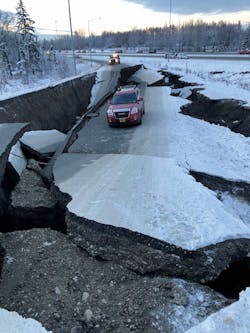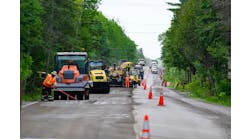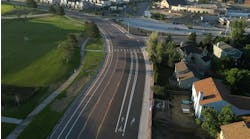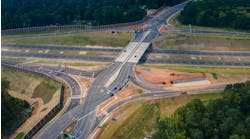You remember hearing about it in the news, I’ll bet.
Late November of 2018: Thanksgiving lingered in most households in the form of leftover turkey sandwiches and protracted arguments about football. Seasonal weather patterns in much of North America had already, more than three weeks before the official start of winter, become surprisingly various—deep chills stripping the last fall leaves from the trees, winds tearing aggressively across the plains states, snowfalls already tiring the north Atlantic coast. Early on the morning of Nov. 30, 2018, a magnitude 7.0 earthquake hit Anchorage, Alaska and its environs—the most significant earthquake to hit the state since a 9.2 was recorded in 1964. The effects were immediate and fairly disastrous. More than 170 subsequent aftershocks were recorded, one clocking in as high as 5.7 just hours after the initial event, and within the first three days more than 32,000 power outages were reported. Schools were closed, the airport shut down, freight came to a standstill. And the cold kept growing still colder. But also within those first three days post-event, a nearly impossible feat was performed on a major roadway leading into and out of Stevens Anchorage International Airport.
The damage wrought at the Minnesota Drive and International Airport Road Interchange—images of which were picked up by every major news service in the world—came to symbolize the widespread effects of the earthquake, and though it was only one of more than 60 locations that would eventually require repair, the manner and means employed by the Alaska DOT & Public Facilities (DOT&PF) and its contracting partners set a new standard for emergency road rescue, and earned it a well-deserved spot among this year’s Roads & Bridges Top 10 Roads honorees.
"THE MOST CHALLENGING PAVING WE'VE EVER DONE.”
In our March 2019 issue, Alaska DOT&PF Northern Region Information Officer Caitlin Frye gave R&B readers a firsthand look at how this destroyed road was addressed, from the first call to the final striping. In that article, Frye wrote: “By 9:30 a.m., only an hour after the earthquake, [DOT&PF Project Engineer] Mahear Abou Eid was at headquarters with an assignment to oversee repairs at the northbound Minnesota off-ramp to International Airport Road. Contractor Knik Construction already was on board as the general contractor. An hour after that, just two hours after the quake, Abou Eid was on-site with the superintendent from Knik Construction. Before noon, the stranded SUV [seen in nearly every photo published of the damage] had been towed, equipment was mobilized on-site, subcontractors were discussing the repair plan, and word came in from the paving subcontractor [Quality Asphalt Paving] that the paving plant was already heating up.”
That’s right: The paving plant was in prep mode within an hour of the event. Late November is a particularly torturous time for paving. As Dave Kemp, DOT&PF’s central region director, said in a press conference two days following the quake, “We’re going to be paving at the worst possible time of year ... This is probably the most challenging paving we’ve ever done.”
Alaska’s construction season, unlike much of the U.S., is short and intense. In the Anchorage region, May to October is pretty much all they get. After that point, the weather becomes too dicey to guarantee anything like quality paving will be possible. One consequence of this is that asphalt plant operators begin to winterize their plant equipment just as soon as that narrow seasonal window closes. By late November, paving operations are already deep in hibernation, unaccustomed to being woken until spring. But the DOT&PF and Quality Paving were against the clock, not just due to the awesome level of damage in front of them, but due also to a weather forecast that predicted a lot of snowfall on the imminent horizon.
As Frye noted in her article, “Under typical circumstances, by the time the contractor and project engineer are talking about paving at a construction site, a whole suite of preparation activities have already taken place: utilities located, buried culverts identified, as-built plans reviewed, design sets stamped, traffic-control plans approved. But these were not typical circumstances—it all had to get done on the fly.”
While there were, thankfully, no gas leaks in the area, a damaged culvert was discovered. As the contractor did not have a replacement on hand, DOT&PF was able to track one down and get it on-site within 90 minutes. “By the time Abou Eid had his phone out to call state maintenance crews to spread some sand on the icy roads,” Frye reported, “he saw a municipal sanding truck roll in—the contractor had called in a favor. Four hours after a landscaping company had been contacted to assist with slope stabilization, their trucks were spraying bonded fiber matrix on the slope.”
The paving work itself proved to be a bear. Although temperatures were much colder than would normally be acceptable for paving, it was not as cold as it could have been. Average temperatures for that time of year range between 15-30°F, but it stayed at the high end—just below 30°F—as paving began. This was felicitous for crew members as they had to overcome both time and temperature challenges to achieve sufficient compaction as the material was put down. Although initial repairs would be temporary—more robust and long-term repairs were performed that summer when conditions were more amicable—the wintertime repairs still had to last for up to eight months. Asphalt is usually heated to about 300-320°F, but Quality Paving got theirs up to 340°F to combat the freezing temperatures outside. The drive from the plant to the site took the trucks only about four minutes, so they were not hampered by a long haul. Nonetheless, the crew waited until two asphalt trucks had arrived before starting the paving to ensure there was a continuous paving process with as little downtime as possible. Trucks only unloaded when the paver was ready to go. The temperature of the asphalt was measured more frequently than normal, but it stayed where it needed to be. It took two passes to pave the 220-ft-long site. The asphalt mat was 3 in. thick—1 in. thicker than usual to keep temperatures up—and by the time the rollers had completed four passes, temperatures were still holding at about 250°F.
At 11 p.m. on Dec. 3, less than 87 hours after the earthquake, striping was completed on the cooled and compacted asphalt, and the ramp was ready for traffic. This wasn’t a “big” project. It was, however, one hell of a big effort and success.



